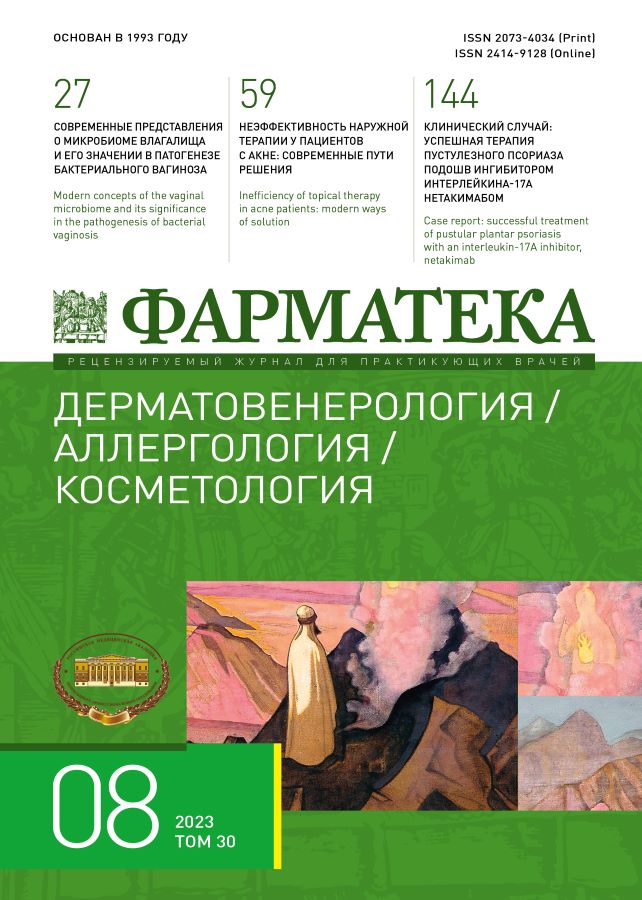Contact dermatitis – a difficult diagnosis: a clinical case
- Autores: Pozdnyakova O.N.1, Chasnyk A.S.2, Nemchaninova О.В.1, Sklyanova E.Y.1, Reshetnikova T.B.1
-
Afiliações:
- Novosibirsk State Medical University
- Novosibirsk National Research State University
- Edição: Volume 30, Nº 8 (2023)
- Páginas: 151-155
- Seção: Clinical case
- ##submission.datePublished##: 10.11.2023
- URL: https://journals.eco-vector.com/2073-4034/article/view/623190
- DOI: https://doi.org/10.18565/pharmateca.2023.8.151-155
- ID: 623190
Citar
Texto integral
Resumo
Background. Contact dermatitis (CD) – irritant and allergic – is a group of skin diseases that are caused by skin contact with irritants or allergens, are characterized by a variety of morphological manifestations depending on the stage of the process and can mimic a wide range of dermatological nosologies. In the treatment of both variants of CD, the main factor is the elimination of the trigger agent/allergen, so it is important to differentiate CD from other skin diseases as early as possible, which will avoid prescribing unreasonable and often unsuccessful treatment.
Description of the clinical case. The article presents a clinical case of allergic contact dermatitis that developed against the background of a long course of scabies in a patient with limited scleroderma.
Conclusion. It is known that the clinical picture of scabies is determined both by the activity of the scabies mite and the allergic reaction of the body to the pathogen and its waste products, which in this case led to the development of complications in the form of allergic dermatitis. The rapid regression of rashes after the appointment of a scabicide convincingly shows how important the elimination of the irritant, in this case, the scabies mite, is for the relief of clinical symptoms of CD.
Texto integral
Sobre autores
O. Pozdnyakova
Novosibirsk State Medical University
Email: annachasnyk@yandex.ru
ORCID ID: 0000-0003-1389-1001
Rússia, Novosibirsk
Anna Chasnyk
Novosibirsk National Research State University
Autor responsável pela correspondência
Email: annachasnyk@yandex.ru
ORCID ID: 0009-0002-3663-1827
Resident in Dermatovenereology, V. Zelman Institute of Medicine and Psychology, Center for Postgraduate Medical Education
Rússia, NovosibirskО. Nemchaninova
Novosibirsk State Medical University
Email: annachasnyk@yandex.ru
ORCID ID: 0000-0002-5961-6980
Rússia, Novosibirsk
E. Sklyanova
Novosibirsk State Medical University
Email: annachasnyk@yandex.ru
ORCID ID: 0000-0001-6028-8585
Rússia, Novosibirsk
T. Reshetnikova
Novosibirsk State Medical University
Email: annachasnyk@yandex.ru
ORCID ID: 0000-0002-6156-0875
Rússia, Novosibirsk
Bibliografia
- Elmas O.F., Akdeniz N., Atasoy M., Karadag A.S. Contact dermatitis: A great imitator. Clin Derma-tol. 2020;38(2):176–92. doi: 10.1016/j.clindermatol.2019.10.003.
- Litchman G., Nair P.A., Atwater A.R., Bhutta B.S. Contact dermatitis. Treasure Island: StatPearls; 2021.
- Novak-Bilic G., Vucic M., Japundzic I., et al. Irritant and allergic contact dermatitis – skin lesion characteristics Acta Clin Croat. 2018;57:713–20. doi: 10.20471/acc.2018.57.04.13.
- Martin S.F., Rustemeyer T., Thyssen J.P. Recent advances in understanding and managing contact dermatitis. F1000Res. 2018;7: F1000 Faculty Rev-810. doi: 10.12688/f1000research.13499.1.
- Bains, S.N., Nash P., Fonacier L. Irritant Contact Dermatitis. Clin Rev Allerg Immunol. 2019;56:99–109. doi: 10.1007/s12016-018-8713-0.
- Клинические рекомендации «Дерматит контактный», 2021. [Clinical recommendations «Contact dermatitis», 2021. (In Russ.)].URL: https://cr.minzdrav.gov.ru/schema/213_2.
- Ерина И.А., Садретдинов Р.А. О дифференциальной диагностике профессиональных дерма-титов и экземы. Центральный научный вестник. 2018;3;21(62):5–6. [Erina I.A., R.A. Sadretdinov. On the differential diagnosis of professional dermatitis and eczema. Central Sci Bull. 2018;3;21(62):5–6. (In Russ.)].
- Uesugi B.A., Sheehan M.P. Patch testing pearls. Clin Rev Allergy Immunol. 2019;56(1):110–18. doi: 10.1007/s12016-018-8715-y.
- Клинические рекомендации «Псориаз», 2023. [Clinical guidelines «Psoriasis», 2023. (In Russ.)]. URL: https://cr.minzdrav.gov.ru/schema/234_2
- Клинические рекомендации «Себорейный дерматит», 2022. [Clinical recommendations «Seborrheic dermatitis», 2022. (In Russ.)]. URL: https://cr.minzdrav.gov.ru/schema/215_2
- Клинические рекомендации «Периоральный дерматит», 2016. [Clinical guidelines «Pe-rioral dermatitis», 2016. (In Russ.)]. URL: https://Дерматит периоральный.КР198.docx (live.com)
- Jha A.K., Sonthalia S., Sarkar R. Dermoscopy of discoid lupus erythematosus. Indian Dermatol On-line J. 2016;7(5):458. doi: 10.4103/2229-5178.190493.
- Crowson A.N., Magro C.M. Cutaneous histopathology of lupus erythematosus. Diagn Histopathol. 2009;15;4:157–85. doi: 10.1034/j.1600-0560.2001.280101.x.
- Клинические рекомендации «Чесотка», 2016. [Clinical recommendations «Scabies», 2016. (In Russ.)]. URL: https://apicr.minzdrav.gov.ru/api.ashx?op=GetClinrecPdf&id=245_1
- Малярчук А.П., Соколова Т.В. Выбор тактики лечения больных осложненной чесоткой. Клиническая дерматология и венерология. 2016;15(6):74–84. [Malyarchuk A.P., Sokolova T.V. The choice of tactics for the treatment of patients with complicated scabies. Klinicheskaya Dermatologiya i Venerologiya. 2016;15(6):74–84. (In Russ.)]. doi: 10.17116/klinderma201615674-84.
Arquivos suplementares














